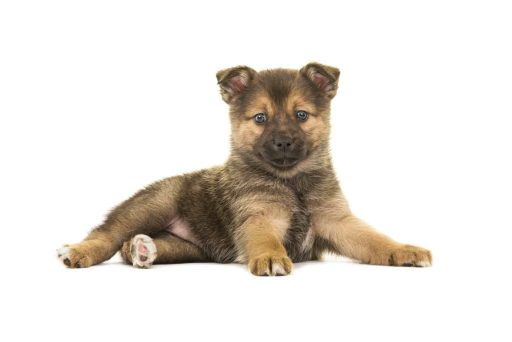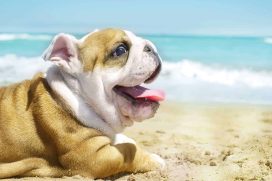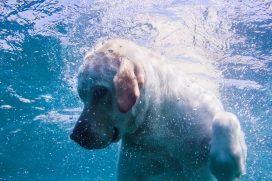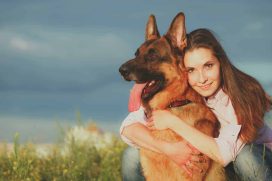The Pomsky originated as an internet myth in 2011. It started out with people posting pictures of cute fluffy puppies, claiming that the pups were from Pomeranian and Siberian Husky parents. The puppies in the pictures were actually Finnish Lapphunds. However, the excitement caused breeders to try breeding Pomeranians with Siberian Huskies. Thus, the Pomsky was born.
What Is A Pomsky?
The Pomsky is an adorable designer crossbreed that mixes the athletic blue eyed Husky with the ever smiling toy breed, the Pomeranian.
Because of the size difference between these two breeds, the Siberian Husky is a female mother and the Pomeranian a male. Both breeds are considered “northern breeds.” This means that they are made for living and working in cold climates.
The Pomeranian is inquisitive and lively. Siberian Huskies are considered outgoing and loyal. Both breeds require a fair amount of exercise. However, the Siberian Husky also likes having a job to do with regular exercise.

When these two breeds are combined into a Pomsky you get a dog who is playful and confident. They require daily brushings and need plenty of exercise.
This is not just a cute little toy breed, and it may not be suited to everyone. Because the breed is so new it can really be a toss-up as to what you will get. A Pomsky pup may be very much like a Pomeranian or it might be very Siberian Husky.
How Big Is A Full Grown Pomsky?
Just like with any crossbreed, the height and weight of the offspring can vary depending on the genetics of the parents.
The Pomsky will usually grow to between 10-15 inches in height. However, there have been some that are reported to have grown as big as a Siberian Husky. Asking the breeder about previous litters may help you figure out how big your pup will be.
When it comes to weight, the Pomsky will usually be between 7-35 pounds. However, if your Pomsky grows to the size of a Husky, then he’s going to weigh more than a small Pomeranian sized Pomsky.
What Color And Type Of Coat Does The Pomsky Have?
The Pomsky is a double coated crossbreed. This means that it has two coats, a coarse outer one that is waterproof and a thick soft undercoat that protects against UV rays and cold weather.
The coat of a Pomsky come in many colors, depending on the coloring of the parent Husky and Pomeranian.
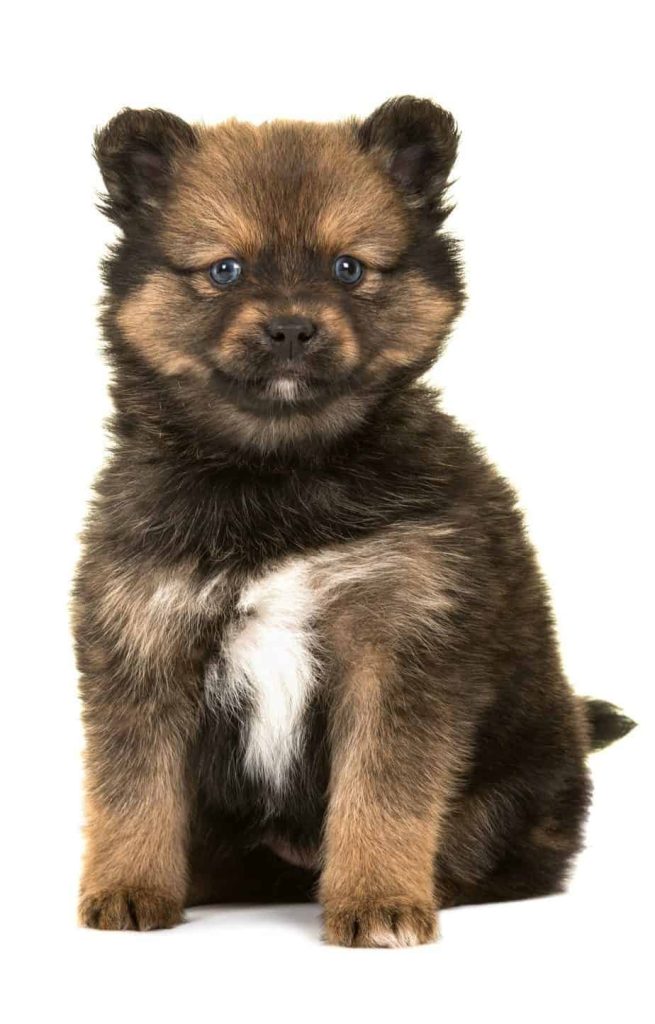
Pomeranians can have lots of different coat colors, over two dozen different colors and patterns to be exact, with red or orange the most common.
Siberian Huskys can be white, black, or a combination of colors with white. They can also be white with black, white with grey, white with brown, to name but a few. The Pomsky puppies that look most like Siberian Huskies are the most popular.
What Kind Of Temperament Does The Pomsky Have?
The temperament of a Pomsky can vary quite a lot, and depends on the personalities of the mother and father.
The parents of a Pomsky are two very different breeds. Siberian Huskies are loyal, protective, and can sometimes be difficult to train. They are bred to work as a pack so they usually get along well with other dogs.
On the other hand, you have the Pomeranian who likes to be the centre of attention and can get jealous of other pets and children.
So as you can see, there are two very different breeds and personalities coming together to make a Pomsky. You could get a Pomsky who is all Siberian Husky, all Pomeranian, or a mixture of the two.
Is The Pomsky A Good Family Dog?
The Pomsky is a fairly small crossbreed, so can do well in apartments as long as they get the exercise and attention they need. Otherwise, they may become excessively barky and your neighbors won’t like it!
They are not well suited to being left alone for long periods, and if they get bored they will be destructive.
A Pomsky may not be the best option for first-time dog owners. Depending on their personality type, they can be quite pushy and demanding. Sometimes they can have one favorite human and they may or may not like the other people in the household. They can also become jealous if “their” person gives anyone else attention. Of course, many breeds are like this and this sort of behavior can controlled with proper training.
The Pomsky also loves to dig and if left alone outside for too long they will dig their way out. It is a good idea to provide your Pomsky with a dedicated digging area. If you catch him digging somewhere else, you can then redirect him to his digging spot. Keep the spot interesting by burying toys and treats when your Pomsky is not looking.
Some say that the Pomsky can do well with children while others say that you should not have small children and a Pomsky at the same time. They can be prone to jealousy, and they don’t always want to share their attention with kids. They also do not like rough handling and are not afraid to bite if they feel they need too.
The Pomsky can do well with other pets as long as they are well socialized with them at a young age. This breed has a high prey drive, so if not properly socialized they will tend to chase smaller pets and cats. Even if the Pomsky is properly socialized, it is a good idea to keep an eye on your Pomsky when he is around other smaller pets.
Is The Pomsky Hypoallergenic?
The Pomsky is not hypoallergenic. They have a thick double coat that sheds year-round. A Pomsy will shed especially heavily in the warmer months. So, depending on where you live that could be 6 months of the year. This breed is not suited to a person with dog allergies.
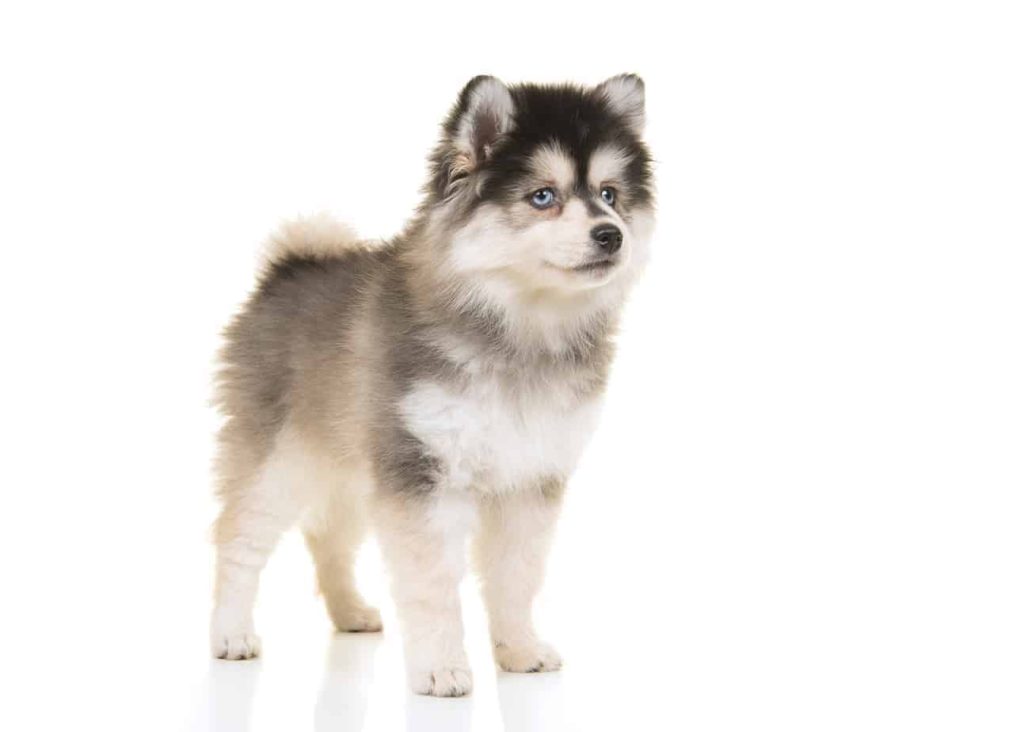
Is The Pomsky Hard To Train?
Socialization is particularly important with the Pomsky breed (and this is probably true for for all dogs). The Pomsky can sometimes be possessive and jealous, or may be shy and fearful. They also have a love of chasing things and will endlessly chase the family cat unless they are trained not to!
Socialization starts with the breeder so be sure to ask the breeder of your Pomsky what their socialization program is like. The puppy should have positive interactions with all sorts of people, animals, places, sights, sounds, and smells. Once you bring the puppy home you need to continue the socialization process.
Socialization is most important when your dog is a puppy. However, it is important to keep socializing for the life of the dog. Always keep moving you and your dog outside your comfort zone, as long as it is a positive experience.
The Pomsky can be difficult to train. Reward-based training is best for this breed. If you find the right motivation they generally become easier to train and will do well learning basic commands.
Try using a variety of treats as rewards. Also, play can be a great reward for a Pomsky since they have such a high prey drive. When they do something right, reward them with a toy and play a quick game of tug or fetch.
Because the Pomsky can be hard to train, and needs extra care with socialization it’s a good idea to enroll in a puppy training class. A good puppy training class will help you train your dog properly. A great puppy training class also offers plenty of socialization time for the puppies.
Does The Pomsky Need Much Exercise?
The Pomsky does well with two 20-30 minutes walks a day plus a couple of play sessions. These dogs may seem small but they are very busy and if you aren’t directing their energy they may become destructive or barky.
The Pomsky is a high energy crossbreed, so it can be worthwhile to enrol them in a dog sport such as agility and rally. This will help to burn their excess mental and physical energy.
When it comes to intense sports like agility, be sure to keep training sessions short and fun. In my experience, it’s a good idea to always stop before your dog wants too. This will make him all the more excited for the next training session.
How Do You Groom A Pomsky?
Grooming a Pomsky can be done mainly at home, however, you can choose to take him to the groomer as well. This breed has a double coat and sheds quite a lot all year round. So it is a good idea to brush your Pomsky on a daily basis, and even brushing your Pomsky twice a day during shedding seasons may also be necessary.
You can brush your Pomsky with a pin brush or a fine-toothed comb. Just be sure that when you are brushing your Pomsky you get down to the skin. It works well to work with small sections at a time. Holding the fur above, out of the way so you can get down to the skin easier. Start with the back leg and work your way up to the front of your Pomsky.
If you feel a pull on the brush then you need to concentrate your efforts in that area. Keep brushing. If you can get a fine-toothed comb through his fur then you know you have gotten out all of the mats. You may also want to go through with a de-shedding tool to get out more fur. This can be especially useful in the neck area as it contains a lot of fur.
Here’s an excellent video showing exactly how to groom a double coated Husky. The Pomsky will usually have a coat that is pretty much the same and can be groomed in the same way.
2. Bathing a Pomsky
You can bathe your Pomsky on an as-needed basis. Depending on coat color and the amount of time they spend outside, you can expect to bathe your Pomsky every 2-6 weeks. This can be done at home or you can have a professional groomer do the job. Be sure to use dog-friendly shampoo and conditioner for your Pomsky.
Because of the double coat, a Pomsky can take a long time to dry out completely. If you want to blow dry them after a bath, use the cool setting of the dryer. Blow dry and comb the fur with a wide-toothed comb at the same time. Doing this will help to dry the fur faster. You should work on getting your Pomsky used to a blow dryer at an early age.
You will want to follow up on the bath by combing through the coat one more time with a fine-toothed comb. Be sure to get to the skin as this helps to remove any undercoat that was loosened during the scrub in the tub.
3. Pomsky Dental Care
Brushing your dog’s teeth and providing them with plenty of appropriate things to chew is essential for good overall health. This is especially true with the Pomsky as they are prone to dental issues.
Most doggie toothpaste will tell you to brush your dog’s teeth 2-3 times per week, However, I find it best to brush daily. Only brushing your dog’s teeth 2-3 times a week makes it very easy to forget. If you brush your dog’s teeth daily it is much easier to make it a habit.
Your Pomsky will thrive with plenty of appropriate things to chew. Raw bones, dehydrated animal ears, dehydrated trachea, and bully sticks are all great options for your Pomsky. Chewing is not only good for dental health but mental health as well. Plus, a good chew will keep the breed occupied for a minute so you don’t have too.
4. Pomsky Nail Trimming:
It is a good idea to trim your Pomsky’s nails every week. This will ensure short nails. If nails get too long they can cause foot pain and even misalignment of the spine. So, keeping your Pomsky’s nails trimmed is very important.
5. Pomsky Ear Cleaning:
Cleaning your Pomsky’s ears should only be done if you notice a buildup of wax or dirt. However, taking a quick peek in each ear daily, is a good idea. That way you can jump on a problem before it becomes too bad. A little wax is normal, but large amounts of wax or an odd smell are indicators that your Pomsky’s ears need to be cleaned.
To clean your Pomsky’s ears simply soak a cotton ball in a mixture of half apple cider vinegar and half filtered water. Use this cotton ball to gently clean the ear. The apple cider vinegar will not only clean the ear but also help to dry it out.
What Health Problems Can A Pomsky Have?
Pomskies can develop any of the health issues of their parent breeds. This means they are prone to allergies, hip dysplasia, luxating patella, eye problems, dental problems, epilepsy, collapsed trachea (walk them on a harness!), and heart issues, among others.
If possible ask about health tests and certifications of the parents of the Pomsky. This will help to ensure that your pup has the best health.
Prevention is the best option. So, be sure to ask your breeder lots of questions about health. Also, be sure to feed your Pomsky well, exercise him enough, and help him to live a life as free from stress and toxins as possible.
What Is The Best Food For A Pomsky And How Much Does A Pomsky Eat?
Some Pomskies can be prone to weight gain while others are not. You can choose kibble, canned, home-prepared, or raw as food options for a Pomsky. Whatever you choose, be sure that it is a high-quality diet that is high in protein and low in carbohydrates.
A diet that is high in protein and low in carbohydrates will be your best defense in preventing chronic disease. Be sure to keep the Pomsky’s treats high protein and low-carb too! Feeding high-quality treats is a must.
As mentioned before the Pomsky can be prone to dental issues so it is very important to offer your Pomsky plenty of appropriate things to chew. These should be meat-based items that are minimally processed. Chews could include dehydrated trachea, freeze-dried rabbit ears, dehydrated lamb or pig ears, bully sticks, or raw meaty bones (never feed cooked bones!).
Be sure to provide your Pomsky with fresh drinking water. Make sure that your dog always has access to fresh water. It is an especially good idea to bring along water when you go on a walk when it is hot outside.
Where Can You Get A Pomsky And How Much Does A Pomsky Cost?
Since the Pomsky is a relatively new breed and is fairly popular, they can be quite expensive. You can expect to pay anywhere from $1000 to $3000 or more, for a Pomsky puppy. Typically you will spend more on the puppies that are more Siberian Husky in appearance as they are more popular.
Getting a Pomsky from a reputable breeder is highly recommended. You can find Pomsky breeders on the International Pomsky Association website. You will want a breeder that is concerned with the health of the litters they produce. You will also want a breeder who is concerned with temperament.
As the Pomsky is a relatively new crossbreed, it can be hard to tell if the breeder is good or not. Lots of breeders have jumped on the Pomsky band-wagon. Some want to solidify the Pomsky as a healthy breed, but others are just looking for profit.
When choosing a Pomsky puppy, meet the breeder and the parents of the litter if possible. Go with your gut, not your heart. Trust me, your heart will melt at the cuteness of the puppies and you will want one, possibly even fall in love with a specific pup. However, you need to go with your gut. If anything bothers you about the breeder, parents, or environment the pup is raised in, find another breeder.
Please never buy a Pomsky at the pet store. These puppies were definitely bred for profit and nothing more. They might be a bit cheaper than getting a Pomsky from a breeder but you will pay for it later in vet bills and private training sessions.
Whilst the breed is still quite new, you can find them in shelters and there are also rescue groups for the breed. If you are interested in a rescue Pomsky you can contact the International Pomsky Association and ask about the options available in your area. You may also be able to contact local Siberian Husky and Pomeranian rescue groups. These purebred rescue groups will often rescue mixes of their breed as well.
It is important to note that a rescue Pomsky was given up for a reason and may be even more challenging to care for than the average Pomsky. They may have more health or behavior problems. However, if you are willing to take on the challenge and have the time and money ready to spend, these dogs deserve forever homes too.
Be especially cautious of rescuing a Pomsky if you have small children or other small pets at home. A rescued Pomsky has an unknown past, and may have had limited socialization and training. It can be very hard to tell how he will do with your other pets or children.
The Pomsky – Summary
The Pomsky is a Pomeranian and Siberian Husky mix. This is a very new breed and as such has a lot of unknowns. When you meet a Pomsky there is no telling whether it will be more Husky or Pom in temperament, size, and energy level. But it will definitely be adorable!
Socialization is of paramount importance to this breed. Positive interactions with as many things and creatures as possible will help to create a well mannered and happy Pomsky. If socialization is not prioritized they will not do well with children and small pets.
The Pomsky can be prone to any of the health issues of the Pomeranian or Siberian Husky. So, it is important to check the health of the parents. Health issues can include eye problems, hip dysplasia, heart issues, epilepsy and more. Feeding a high-protein, low-carb diet is of great importance for the prevention of health issues.
It is also important to give the Pomsky plenty of exercise and things to do. A Pomsky may become barky or display behavioral issues if not kept busy. If you are set on getting a Pomsky start thinking about ways to keep him busy now.
This breed sheds quite a lot so daily brushing is recommended. The breed will also need an occasional bath. Professional grooming is not required, but you can use a groomer if you desire.
The Pomsky is not for everyone. He can be pushy and demanding. He is not the best for households with children or small pets. However, he can be a wonderful companion for some people. Think carefully before you decide to get this breed.

